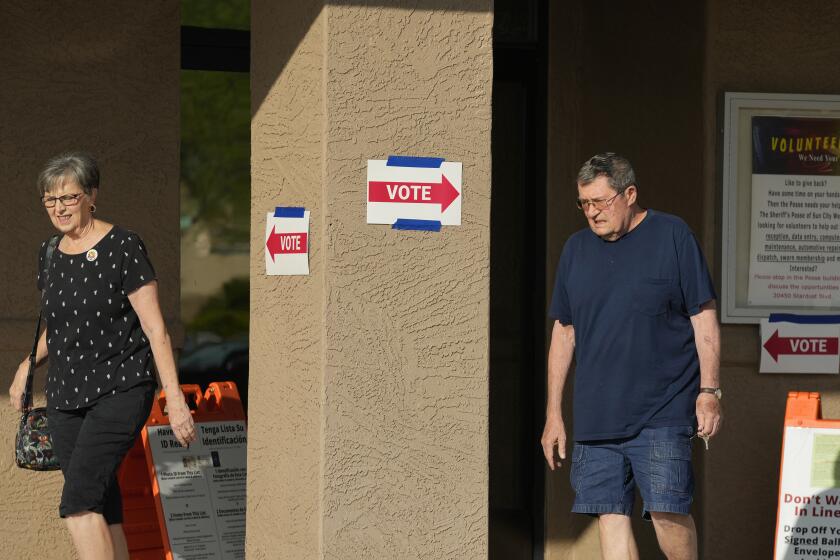A plan for getting California’s fiscal house in order
Charles Dickens would have been flummoxed by the Golden State in 2009. It was the worst of times, pure and simple, with no “best” to balance out the ledger.
At the start of the last calendar year, the state of California was staring down the barrel of a $42-billion budget deficit looming for 2009-10. By midyear, when negotiations between Gov. Arnold Schwarzenegger and the Legislature got serious, the gap had widened to $60 billion.
Sacramento closed that chasm with its usual patented formula of draconian budget cuts, imaginary savings and outright thievery from city and county fiscal larders. But this did nothing to solve the state’s structural budget imbalance. A forecast last month from the nonpartisan Legislative Analyst’s Office pegged the budget deficit facing the state now at $20.7 billion, including a $6.3-billion hangover from the current year and a $14.4-billion shortfall for 2010-11. Last week the governor called for more deep cuts in state programs and said he would appeal for federal aid to help close the gap.
In the future, the LAO said, the state will face a continuing budget deficit of $20 billion a year. That’s equal to the combined salary of all 306,000 elementary and high school teachers in the state. Even with an “unexpectedly strong economic recovery,” the analyst’s office added, there is “no way the state can avoid reprioritizing its finances” -- both through significant reductions in major state programs and new revenues.
That pretty much defines the mandate for the state of California in 2010. The time for wishful thinking and fiscal fantasy has passed.
Luckily, we will have an opportunity to air all the possible solutions to our fiscal mess this year through the mechanism of a gubernatorial election.
Unluckily, most of the leading candidates for the job have shown thus far that on fiscal and economic policies, they are clueless.
Let’s start our examination of the coming year in California by listing in broad strokes what needs to be done.
First and foremost is a sweeping change in governance rules. No progress can be made in setting the state on solid fiscal ground as long as the Legislature remains a permanent novitiate. Spending and revenues can’t be managed without deferring to a tiny minority with an outsized veto, and any special interest with a few million dollars to spend on signature-gathering and television ads can perform an end run around the Legislature at the ballot box.
In practice, this means a loosening of legislative term limits, a change in the rules requiring two-thirds votes in both houses to pass a budget or raise taxes, and a clampdown on ballot initiatives -- especially those mandating new spending programs.
As I’ve written before, the stringent rules on passing a budget haven’t made our budgets better but immeasurably worse. The rules give a powerful veto to a small cadre of Republican legislators adhering to a no-new-taxes pledge. That makes it impossible for the state to match revenues and spending without budgetary legerdemain that invariably pushes costs off to future years, like time bombs.
Fans of the supermajority rule often argue that it’s the only thing keeping the Democratsin the Legislature from impoverishing all taxpaying Californians (at least that’s the theme of many e-mails I get from readers). The truth is that the real drivers of spending are the voters, who blithely sign off on program after program at the ballot box, year after year.
Preschool programs, after-school programs, a stem-cell program, new prisons, new bond issues, borrowing to balance the budget -- these were all enacted by voter initiative, often on the same ballot at which they enacted a special-interest tax break. Arguably they’re all worthy programs, but ballot initiatives are no way to “reprioritize” spending.
California can’t get its fiscal house in order without restricting initiatives, whether by requiring that every spending measure identify a new source of revenue, by funneling major initiatives to major elections that can’t be easily swung by single-issue voters, or both.
This needs to be paired with measures that increase the professionalism of the Legislature so that lawmakers have the skills and experience to handle important decisions on spending priorities, and that means loosening or eliminating term limits. There have been nine speakers of the state Assembly since mid-1995 (we’re soon to get a 10th). Over the previous 20 years, there were two, including Willie Brown, the chief target of the term-limit movement. If there’s any evidence that the change has improved state government, I’d like to see it.
Most of these reforms would require voter approval. It may already be too late to get them on a 2010 ballot but not too late to get the ball rolling, regardless of whether the wiser course would be to address them one by one or through a constitutional convention.
One proposal that will be placed before the voters in the new year would institute open primaries, allowing the top two vote-getters in the primary to run in the general election, regardless of party. The hope is that this would reduce the political extremism in the Legislature on both sides of the aisle, and that would, in turn, start the long process of restoring public respect to this rightly maligned body.
Another crucial change the state needs is for us to acknowledge the role the educational system plays in the state’s economy.
California can’t move forward by importing trained and educated workers from other states; it must grow its own. Yet public colleges and universities are being cut to shreds, programs eliminated wholesale and enrollments slashed by thousands at a time. Every business lobby and political candidate pays lip service to the importance of a strong public university system, but precious few are willing to go to the mat to preserve programs and enrollment slots.
The civics textbooks tell us that this year’s gubernatorial election should be an ideal stage on which to air solutions to all these problems. But most of the leading candidates have so far shown that they’re prepared to run for office but not to govern if they get there.
On the Republican side, former EBay Chief Executive Meg Whitman is the best-financed candidate -- and also the most enamored of vacuous promises. She proposes to lay off 40,000 state workers, or close to 20% of the payroll. She promises to improve education. She also promises to build more state prisons, although this year nearly $9 billion of the general fund will be devoted to corrections -- more than its spending on the University of California, Cal State, and the community colleges combined, according to the Legislative Analyst’s Office.
Solving the state’s water crisis, which involves the conflicting demands of farmers, industries and urban consumers? “We need to put everyone in a room right now and say we’re locking the door until we get a common point of view on what we’re going to do,” she says, sounding like another Schwarzenegger.
Whitman’s chief GOP rival and fellow millionaire, Insurance Commissioner Steve Poizner, has built his campaign around a promise of tax cuts. He says he’ll spread these evenly, but his program is to enact 10% cuts in the income tax, sales tax, and corporate tax -- and a whopping 50% cut in the capital gains tax.
This sounds like a pure giveaway to the wealthy, and also like a budget-buster. In the fat fiscal year of 2006-07, stock options and capital gains generated $14 billion in state revenue.
Poizner doesn’t say how he would make up the $7-billion loss his plan would produce in such a year.
Poizner does suggest a worthwhile plan to offer entrepreneurs a much-needed one-stop shop to help navigate state business regulations, but he should expand it. Why not set up an office to help all businesses work with regulators and clear away obstacles to expansion?
The third Republican candidate, former U.S. Rep. Tom Campbell, stands alone in showing an understanding of the real issues facing the state budget.
He proposes rolling back some state taxes but making up for it by increasing the state gasoline tax.
In return for this GOP apostasy, he would ask Democrats to pressure state employee unions to give up some of their perks, including rich retirement benefits that have all but disappeared in the private sector. And he turns thumbs down on some of the fake solutions conjured up during budget negotiations this year, including inflated estimates of savings from program cuts and the sale of state assets.
Campbell’s campaign may well be a test of whether ideas can trump dollars in California politics. As of the June 30 reporting period, he had raised $300,000. He says his war chest has now reached $1 million, but that’s still far behind what Poizner ($4.6 million) and Whitman ($10.8 million) had raised as of six months ago (much of it coming from themselves).
That leaves Jerry Brown, the state attorney general, the putative Democratic candidate. I’d love to critique Brown’s position on the structural and budget issues facing the state, but he’s been utterly silent on topic. His campaign so far has stuck to trumpeting his achievements as attorney general, such as settling fraud charges with banks and drug companies and suing carwashes.
But it’s high time we started to hear serious talk about solving the state’s most urgent problems. The governor’s race is a bully pulpit, but up to now it’s been almost empty.
Michael Hiltzik’s column usually runs Mondays and Thursdays. Reach him at michael.hiltzik@latimes.com and read earlier columns at www.latimes.com/hiltzik.
More to Read
Get the L.A. Times Politics newsletter
Deeply reported insights into legislation, politics and policy from Sacramento, Washington and beyond. In your inbox three times per week.
You may occasionally receive promotional content from the Los Angeles Times.











